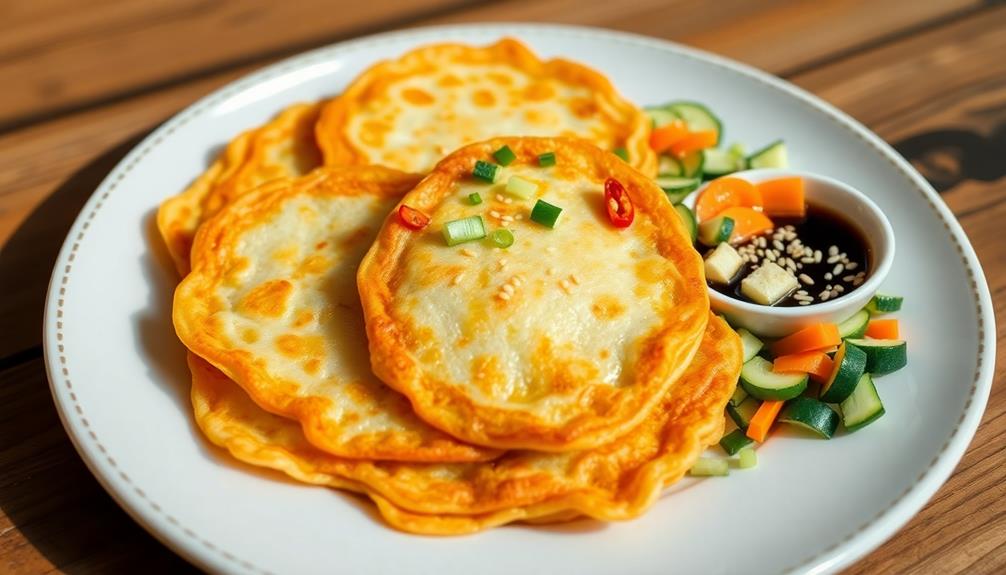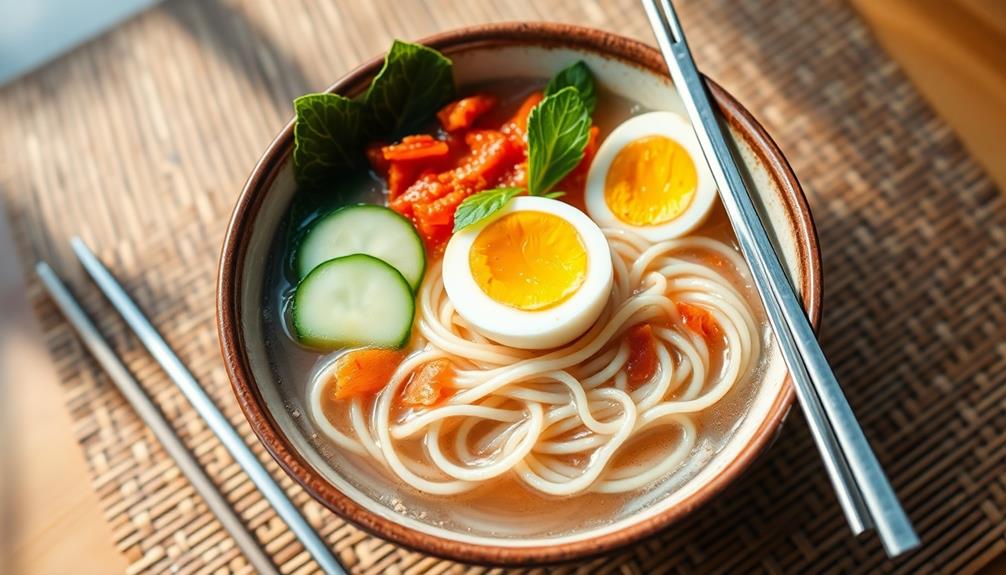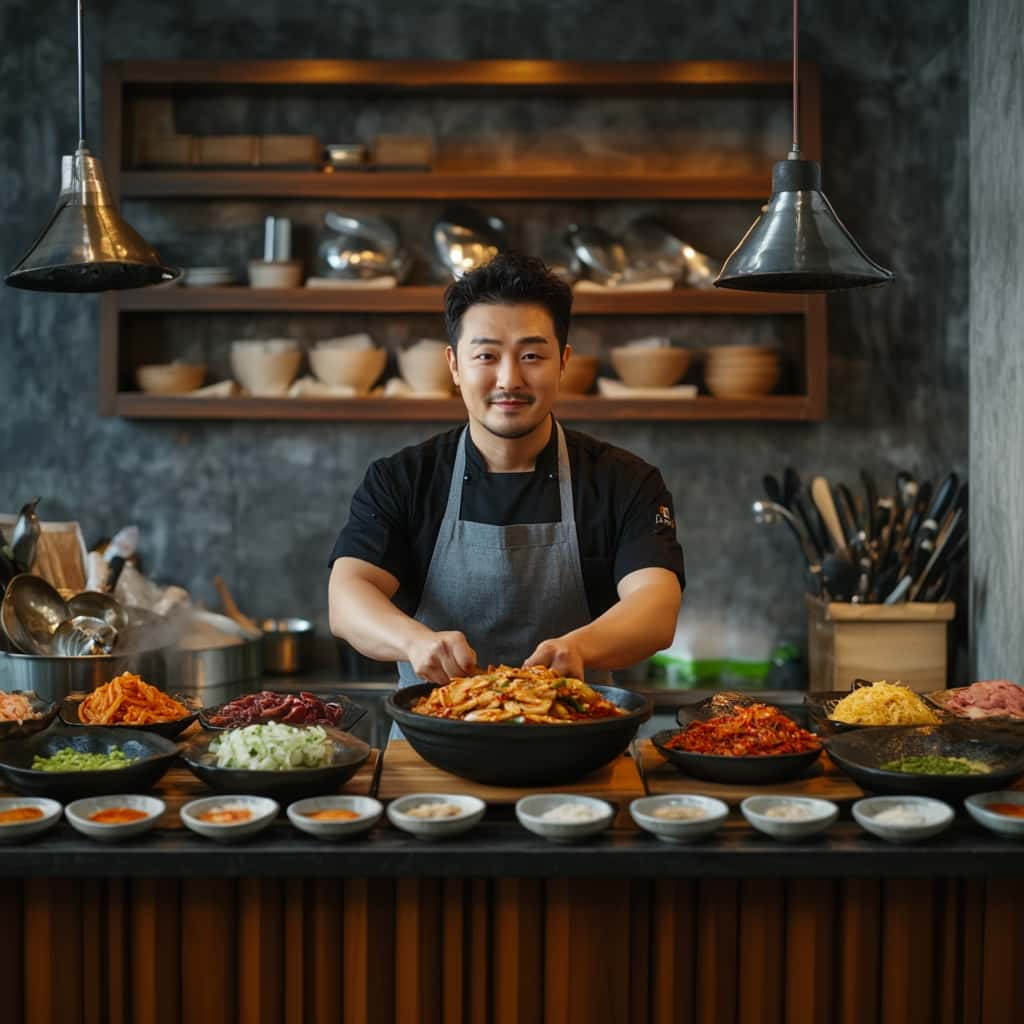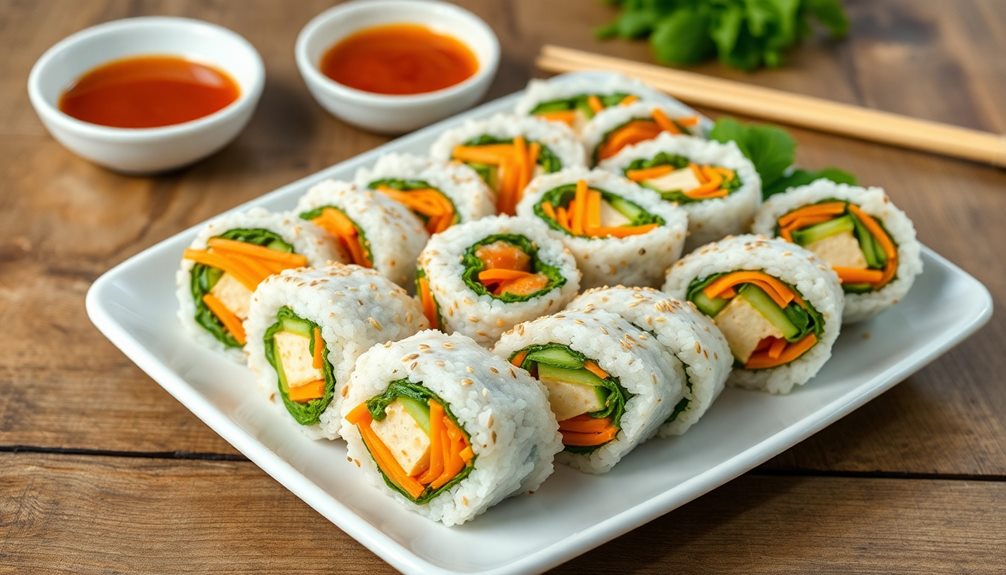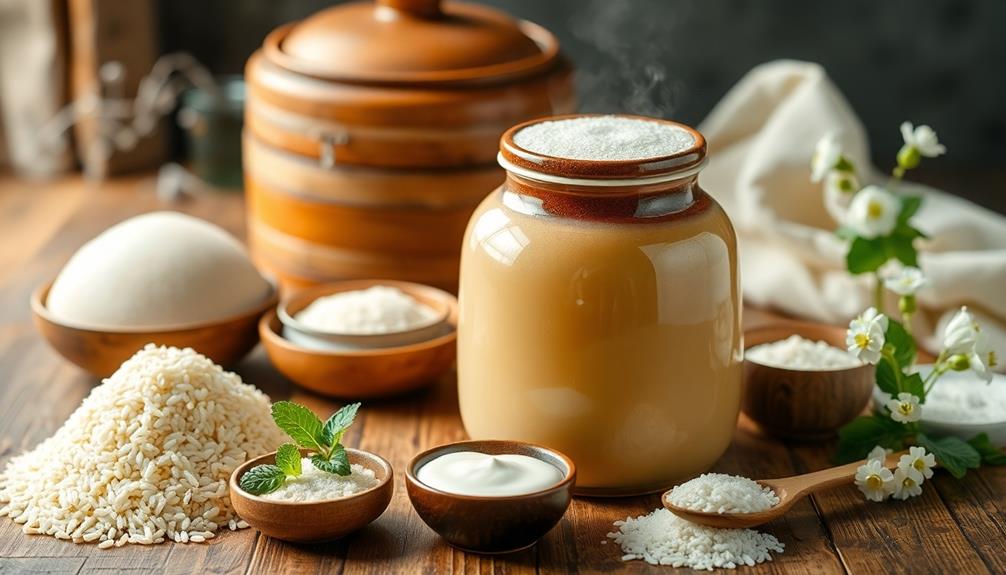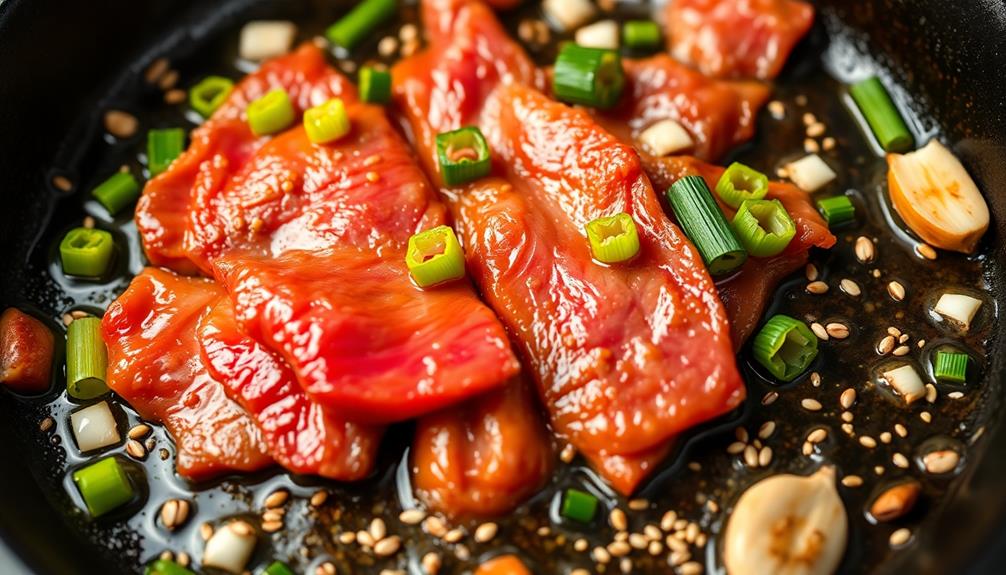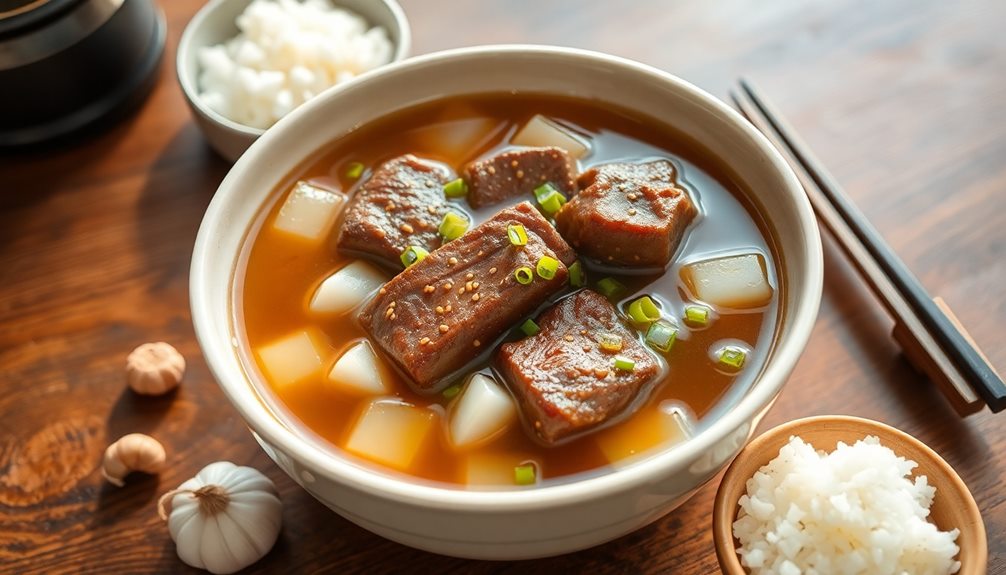Jeon, those delicious Korean pancakes, are a fun way to enjoy tasty treats! They're made with a crispy outside and soft inside, filled with yummy ingredients like veggies, seafood, or meat. You mix flour, water, and an egg to create the batter, then cook them until golden brown. Imagine flipping those pancakes while they sizzle in the pan—what a treat! Jeon can be served as a snack, appetizer, or even a main dish, especially with some soy sauce for dipping. So, grab your ingredients, and let's get cooking, because there's so much more to discover about these delightful pancakes! If you want to try a different twist on Jeon, you can experiment with a seafood green onion pancake recipe. This version adds a savory seafood flavor and a touch of freshness from the green onions. It’s a delicious variation that will bring a new dimension to your Jeon experience. So, next time you’re in the mood for a flavorful and satisfying snack, give this recipe a try!
Key Takeaways
- Jeon are traditional Korean pancakes made with a batter of flour, water, and various fillings, often served during special occasions.
- Common ingredients include vegetables, seafood, or meat, creating customizable flavors suited for different tastes.
- Cooking involves mixing ingredients, frying in oil until golden brown, and serving with dipping sauces like soy sauce.
- Jeon can be enjoyed as a snack, appetizer, or main dish, making them versatile for any meal.
- The dish embodies Korean culinary heritage, promoting communal cooking and sharing among family and friends.
History
Korean pancakes, or "jeon," have a rich history that dates back centuries. These tasty treats are more than just delicious snacks; they come from a long tradition in Korean culture. Can you imagine eating something that people have enjoyed for hundreds of years?
Jeon was often made to celebrate special occasions, like holidays and family gatherings. In the past, families would gather in the kitchen, mixing ingredients together, and laughing as they cooked. You'd find all kinds of fillings in jeon, from vegetables to seafood, making each pancake unique and flavorful.
People loved to share their jeon recipes, passing down secrets from generation to generation. The beauty of jeon is that you can find variations across different regions! In some areas, they might add spicy ingredients, while in others, you might taste sweeter versions.
It's like a delicious treasure hunt! So, the next time you see a plate of jeon, remember that you're enjoying a piece of history, lovingly crafted by generations before you. Isn't that amazing?
Recipe
Korean pancakes, also known as "jeon," are a delightful dish that can be enjoyed as a snack, appetizer, or even a main course. These savory pancakes are made with a variety of ingredients, often featuring vegetables, seafood, or meat, all mixed into a simple batter. They're crispy on the outside and tender on the inside, making them a favorite among many.
The beauty of Korean pancakes lies in their versatility; you can customize them to suit your taste by adding your preferred fillings.
To make Korean pancakes, you'll need a few basic ingredients and some fresh vegetables or proteins of your choice. The batter is typically made from flour and water, which creates a light and crispy texture when fried. Once cooked, these pancakes are often served with a dipping sauce that enhances their flavor. Perfect for sharing at gatherings or enjoying as a comforting meal at home, Korean pancakes are sure to impress your family and friends.
Ingredients:
- 1 cup all-purpose flour
- 1 cup water
- 1 egg
- 1 teaspoon salt
- 1 cup chopped vegetables (e.g., green onions, zucchini, carrots)
- Optional: 1 cup seafood (e.g., shrimp, squid) or cooked meat
- Vegetable oil for frying
- Soy sauce and vinegar for dipping sauce
To prepare the pancakes, start by whisking together the flour, water, egg, and salt in a large mixing bowl until smooth. Then, gently fold in your choice of chopped vegetables and any optional seafood or meat.
Heat a non-stick skillet over medium heat and add a generous amount of vegetable oil. Pour a ladleful of the batter into the skillet, spreading it out into a thin, even layer. Cook for about 3-4 minutes on each side, or until golden brown and crispy. Repeat with the remaining batter, adding more oil to the skillet as needed.
When making Korean pancakes, it's important to ensure that the oil is hot enough before adding the batter; this will help achieve that desired crispiness. You can also experiment with different fillings to find your favorite combination. For an extra burst of flavor, consider adding chopped garlic or ginger to the batter.
Cooking Steps
Now that you've got all your ingredients ready, it's time to start cooking those delicious Korean pancakes!
First, you'll mix the batter thoroughly, ensuring everything is well combined.
Then, you'll heat up the skillet and pour in the batter, cooking it until it's golden brown and ready to enjoy—yum!
Step 1. Gather All Ingredients
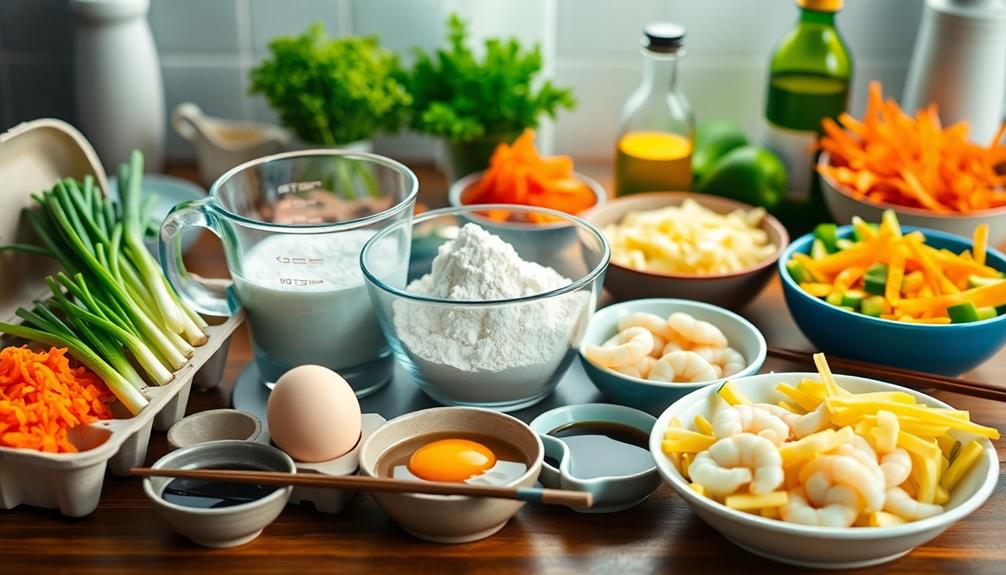
When it comes to making delicious pancakes, gathering all the right ingredients is key to achieving the perfect flavor and texture. First things first, you'll need some basic ingredients like flour, water, and salt. These are the building blocks of your pancake batter.
Next, grab some veggies or meat for added yumminess! You might want to try green onions, zucchini, or even shrimp. Trust me, they'll make your pancakes pop with flavor!
Don't forget about the egg! It helps bind everything together, making your pancakes fluffy and tasty. If you're feeling adventurous, you can also add some spices like pepper or garlic for an extra kick.
And, of course, keep some oil handy for frying – it'll give your pancakes that lovely golden-brown color we all love.
As you gather these ingredients, imagine how amazing your kitchen will smell while they cook. So, roll up your sleeves, and let's get ready to make some fantastic Korean pancakes!
With everything prepped and ready, you'll be one step closer to flipping those delicious jeon. Happy cooking!
Step 2. Mix Batter Thoroughly
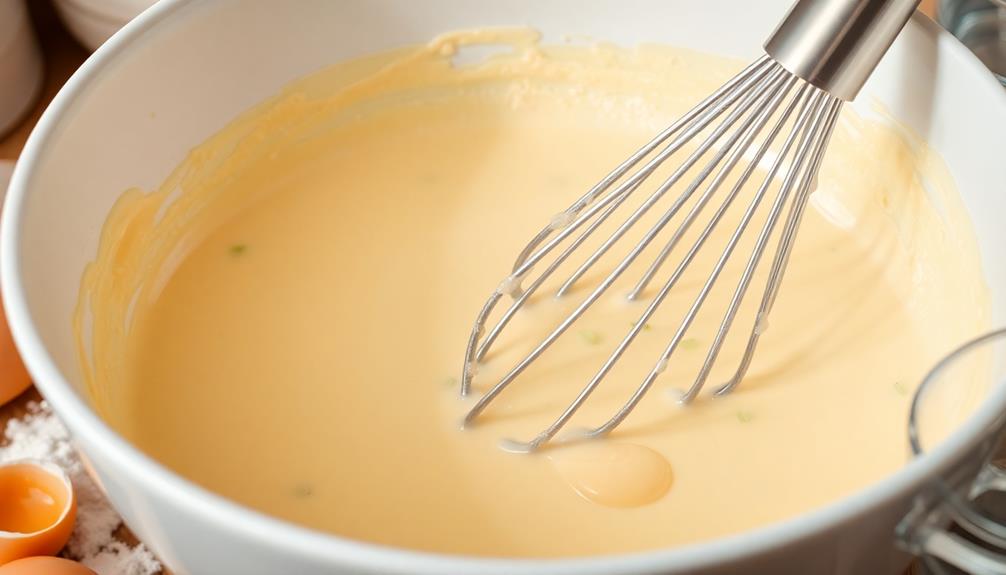
With all your ingredients gathered, it's time to mix the batter thoroughly. First, grab a large bowl and add your flour, water, and any spices or seasonings you like.
Don't forget to toss in your chopped veggies or proteins, too! Now, use a whisk or fork to mix everything together until it's smooth and well combined. It's important to break up any lumps, so give it some good elbow grease!
You want the batter to be a bit thicker than pancake batter but not too thick that it won't spread in the skillet. If you find it's too thick, just add a splash more water to loosen it up.
As you mix, imagine all the delicious flavors coming together—yum! Keep tasting the batter, too; it's a great way to sneak in a little preview of the final dish.
Once it's mixed, let it sit for a few minutes. This helps the flour absorb the liquid, making your pancakes even better!
Step 3. Heat the Skillet
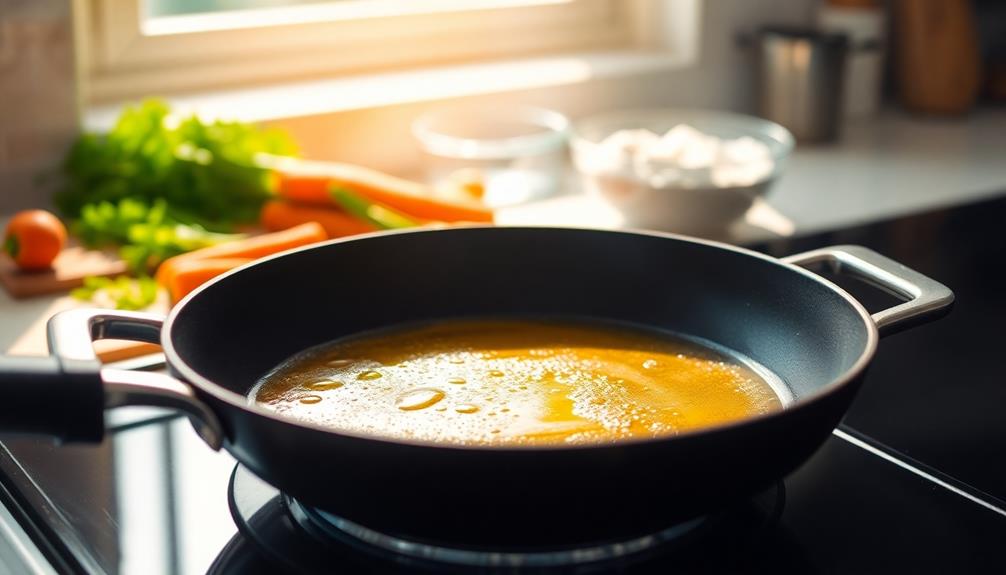
To achieve perfectly cooked Korean pancakes, start by heating your skillet over medium-high heat. You want it nice and hot because a sizzling surface helps create that delicious golden-brown crust. You can use a non-stick skillet or a cast-iron one, depending on what you have.
If you're using cast iron, make sure it's well-seasoned to prevent sticking—nobody wants pancake drama!
While your skillet heats up, you can prepare your oil. A splash of vegetable oil or sesame oil will do the trick. Once the skillet is hot—you can test it by flicking a drop of water onto the surface; if it dances and evaporates, you're ready to go—carefully add the oil. Let it coat the bottom of the skillet evenly.
Now, here comes the fun part: listen for that sizzle! If you hear it, you're on the right track. Just remember, don't overcrowd the skillet; leave some space for the pancakes to spread out and cook evenly.
This way, you'll end up with the crispy edges that everyone loves. So, get ready to make some yummy pancakes!
Step 4. Pour Batter Into Skillet

Now that your skillet is sizzling and coated in oil, it's time to pour the batter in! Grab a ladle or a measuring cup and scoop up some of that delicious pancake batter. You'll want to pour it gently into the center of the skillet, allowing it to spread out a bit on its own. If you like, you can use the back of the ladle to help shape it into a nice round pancake, about the size of a dinner plate.
But wait! Make sure you're not crowding the skillet. Leave enough space between each pancake so they can cook evenly. If you're making more than one, you might want to do them in batches. That way, you won't end up with a jumbled pancake mess!
As you pour, listen closely to the satisfying sizzle of the batter hitting the hot oil. It's like music to your ears!
If you notice any air bubbles forming in the batter, that's a good sign—it means it's cooking nicely. Now, just sit back and get ready for the next exciting step in making your tasty Korean pancakes!
Step 5. Cook Until Golden Brown

As the batter cooks, keep a close eye on it until the edges start to turn golden brown and crispy. You might notice some bubbles forming on the surface—this is a good sign! It means your pancake is cooking perfectly.
Use a spatula to gently lift one edge and peek underneath. If it's golden brown, it's time to flip!
Carefully slide your spatula under the pancake, and with a quick motion, flip it over. Don't worry if it doesn't land perfectly—this isn't a pancake gymnastics competition!
Now, let the other side cook for about 3 to 4 minutes. You want it to match that lovely golden brown color.
While you wait, maybe dance a little in the kitchen or sing your favorite song. Cooking should be fun!
Once both sides are golden and crispy, you can remove the pancake from the skillet and place it on a plate.
Repeat this with the remaining batter, adding a little oil to the pan as needed. Soon enough, you'll have a delicious stack of crispy jeon ready to enjoy! Dip them in some soy sauce, and get ready for a tasty treat!
Final Thoughts
Korean pancakes offer a delightful culinary experience that's both satisfying and versatile. You can whip up these tasty treats for breakfast, lunch, or even dinner!
With endless filling choices like vegetables, seafood, or meat, there's a pancake for everyone to enjoy. Plus, they're super easy to make, so you'll have fun cooking them with family or friends.
Imagine gathering around the table, sharing your creations, and laughing together as you taste test each pancake. The crispy exterior and soft inside will have you hooked in no time.
Don't forget to dip your pancakes in soy sauce or a spicy dip to take the flavor up a notch!
When you try making Korean pancakes, you're not just cooking; you're also embracing a piece of Korean culture. So, grab your ingredients and get ready to create something delicious!
Whether you like them thick and fluffy or thin and crispy, there's no wrong way to enjoy them. So, why wait? Dive into the world of Korean pancakes, and let your taste buds dance with joy!
Happy cooking, and may your pancakes always turn out golden brown!
Frequently Asked Questions
What Are the Main Ingredients Used in Jeon?
When you think about savory pancakes, consider ingredients like flour, water, and your choice of vegetables or proteins. These basic components come together to create delicious, versatile dishes that can suit any palate.
Can Jeon Be Made Gluten-Free?
Yes, you can definitely make it gluten-free! Just replace regular flour with a gluten-free blend or use alternatives like rice flour or chickpea flour. Experimenting with different ingredients can lead to delicious results you'll love!
How Should Jeon Be Stored After Cooking?
After cooking, you should store them in an airtight container. Let them cool completely before sealing, and keep them in the fridge for up to three days. Reheat them on a skillet for best results.
What Are Popular Dipping Sauces for Jeon?
For savory dishes, you'll love soy sauce mixed with vinegar and sesame oil. If you prefer something sweeter, try a spicy gochujang dip or a simple honey and soy sauce blend. Enjoy experimenting with flavors!
Are There Regional Variations of Jeon in Korea?
Yes, there're regional variations in Korea. Depending on where you go, you'll find different ingredients and flavors. Each area brings its own twist, making the experience unique and exciting for your taste buds. Enjoy exploring!
